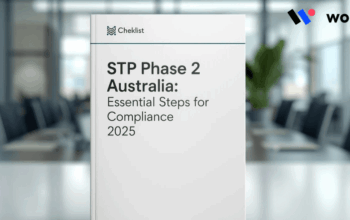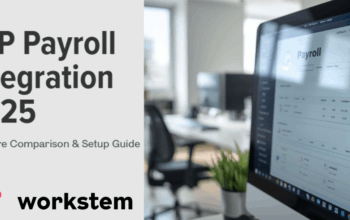Quick Facts: STP Phase 2 at a Glance
Mandatory Migration Deadline: Most employers were required to transition to STP Phase 2 by 1 March 2022. Deferred deadlines for some providers have now passed.
- Key Action Now: Focus on ongoing, accurate reporting with each pay event.
- Finalisation Deadline: Submit your Finalisation Declaration for the financial year by 14 July.
- Core Change: STP Phase 2 requires more detailed data reporting, including disaggregation of gross earnings and new income types.
STP Phase 2: Current Status & Your Ongoing Compliance Requirements
The mandatory migration to Single Touch Payroll Phase 2 (STP Phase 2) is complete for the vast majority of Australian employers. While the transition is over, your compliance journey is a continuous one. STP Phase 2 is now the permanent framework for payroll reporting, meaning accuracy and timeliness are ongoing obligations.
The ATO uses this enhanced, real-time data not only for tax and super but also to support Services Australia with the administration of key social welfare programs. This makes your correct reporting directly impactful.
What Businesses Must Do Now That Migration is Complete
With the technical upgrade behind you, the focus shifts to perfecting your daily processes. Your goal is to ensure your payroll system is not just configured, but is being used correctly to capture the new, granular data requirements with every single pay run.
Immediate Post-Migration Checklist:
- Data Audit: Conduct a thorough review of employee records. Verify that each employee is assigned the correct Income Type (e.g., Salary & Wages, Closely Held Payee) and Tax Treatment.
- Process Review: Map out your payroll process to ensure new data points (like specific allowance types or leave codes) are being captured accurately at the source.
- Team Training: Ensure your payroll team is confident and trained on the new fields and their meanings to prevent misclassification.
Key Phase 2 Features & Their Impact on Daily Operations
STP Phase 2’s core purpose is to provide a more detailed and accurate picture of payroll to the government. The following chart highlights the key reporting differences you need to manage daily:
|
Feature |
STP Phase 1 | STP Phase 2 | Impact on Daily Operations |
|
Gross Income |
Reported as a single total figure | Must be disaggregated into categories (ordinary time, overtime, allowances, leave, etc.) | Requires more detailed payroll coding for each pay element. |
|
Income Types |
Not formally reported | Mandatory reporting of income type for each employee (e.g., salary, closely held payee, labour hire) |
Initial setup is critical. Misclassification leads to reporting errors. |
| Allowances | Often grouped together | Reported with specific allowance codes (e.g., laundry, travel, meals) |
Need to identify and correctly code each unique allowance type. |
| Employment Basis |
Not reported |
Must report the employment basis (e.g., full-time, part-time, casual) |
Adds another layer of data validation for employee setup. |
In practice, this means your payroll processing requires greater precision and a deeper understanding of pay categories to avoid rejections or inaccuracies.
Ongoing Employer Obligations & Reporting Requirements
Your STP Phase 2 duties are recurring. Here’s a breakdown of the key compliance tasks:
- With Every Pay Event: Report the full, enhanced data set to the ATO on or before each pay day. This is your most frequent obligation.
- Finalisation Declaration: By 14 July each year, you must finalise your STP data for the previous financial year. This locks the data and informs the ATO and your employees that it is complete. This replaces the old Payment Summary system.
- Record Keeping: Maintain up-to-date and accurate employee records within your payroll system. Any change in an employee’s circumstances (e.g., tax declaration, residency status) must be reflected in your next report.
- Timely Payments: Remember, STP is a reporting mechanism. It does not change the due dates for paying withheld tax to the ATO or super guarantee contributions to funds.
Common Post-Migration Issues & Practical Solutions
Even after a successful migration, businesses can encounter hiccups.
- Data Accuracy Problems: Misclassifying an income type or incorrectly coding an allowance is the most common error.
- Solution: Implement a multi-step verification process in your payroll workflow. Use software like Workstem that provides built-in validation checks and prompts for these critical fields, preventing errors before submission.
- Reporting Failures: Connectivity issues or file format errors can cause a submission to fail.
- Solution: Choose a reliable platform with clear alert systems. Workstem provides immediate confirmation of successful submissions or detailed error messages for failures, allowing for quick rectification.
- System Disconnects: Manually transferring data between separate time-and-attendance and payroll systems introduces errors and creates friction.
- Solution: An all-in-one platform is the most robust solution. Workstem’s integrated system combines time tracking, payroll, and STP reporting, ensuring data flows seamlessly from clock-on to ATO submission without manual intervention.
How Workstem Helps Manage STP Obligations?
Ensure your business remains compliant effortlessly. Let Workstem’s automated payroll and integrated STP Phase 2 reporting handle the complexity for you. Explore Workstem’s STP Solution today and ensure peace of mind with every pay run.
Simplify award interpretation and payroll processing with Workstem, the all-in-one workforce management & payroll software designed for every industry.Workstem is an ATO-approved STP Phase 2 solution that simplifies compliance by automating the entire process:
- Built-in Validation: Workstem’s software is designed with the correct STP Phase 2 fields and categories, guiding you to enter data correctly and reducing errors.
- Seamless Integration: As an all-in-one platform, Workstem integrates time & attendance, payroll, and STP reporting. This eliminates manual data entry between systems, ensuring the data you report is accurate and consistent.
- Easy Submissions: Reporting is done with a single click at the end of each pay run, with immediate confirmation from the ATO.
- Simplified Finalisation: The year-end finalisation process is streamlined and can be completed in minutes.
Choose from our Standard or Advanced plan to suit your business needs, and stay Fair Work compliant with confidence.
FAQs About the Single Touch Payroll (STP)
Q1: What is Single Touch Payroll (STP) in simple terms?
A: Single Touch Payroll (STP) is a mandatory Australian government initiative that requires businesses to report their employees’ payroll information—such as salaries, wages, pay-as-you-go (PAYG) withholding, and superannuation—to the Australian Taxation Office (ATO) directly from their payroll software each time they run payroll. It’s “single touch” because the reporting happens with a single action at the same time as you pay your staff.
Q2: Who needs to report through STP?
A: Essentially, all Australian employers must report through STP.If you have even one employee, you are generally required to use STP.
Q3: What is the difference between STP Phase 1 and STP Phase 2?
A: STP Phase 2 expands the reporting requirements introduced in Phase 1. The key difference is the level of detail provided to the ATO.
- STP Phase 1 reported total amounts for key figures like gross earnings and tax withheld.
- STP Phase 2 requires a detailed, disaggregated breakdown of an employee’s income (e.g., separating salary, overtime, allowances, and leave payments).
Q4: What are my ongoing STP reporting obligations?
A: Your main ongoing obligations are:
- Report Each Pay Event: Submit the required data to the ATO on or before every pay day.
- Year-End Finalisation: Finalise your data by 14 July each year. This declares the information for the financial year is complete and correct. This replaces the need to provide payment summaries to your employees.
- Keep Records Accurate: Ensure employee details in your payroll software are always up-to-date (e.g., tax declarations, super fund choice).
Q5: I missed the STP Phase 2 migration deadline. What should I do?
A: You should take action immediately:
- Contact your software provider to start the transition process.
- Lodge a voluntary disclosure with the ATO to explain the delay. The ATO generally looks favorably upon businesses that come forward voluntarily and may provide you with a compliance plan or extra time to transition.
- Ensure you are using an ATO-approved STP Phase 2 solution, like Workstem, to become compliant.
Q6: How does STP help with my employees’ Superannuation?
A: While STP itself does not pay your super, it reports the liability for superannuation to the ATO each payday. This allows the ATO to better monitor and ensure that employers are meeting their super guarantee obligations on time. You still need to pay your super contributions to your employees’ funds by the quarterly due dates.
Q7: Does STP change when I have to pay my tax and super?
A: No. STP is a reporting system, not a payment system. The due dates for paying the PAYG withholding tax you report to the ATO and your super guarantee contributions to funds remain unchanged.
Q8: What happens if I make a mistake in my STP report?
A: Mistakes can be fixed. If you discover an error in a past submission, you can make a STP amendment through your payroll software. You simply correct the information in your system and submit a revised update to the ATO. It’s important to correct errors as soon as you find
Q9: Where can I find official information from the ATO?
A9: The best source of truth is always the official ATO website. You can find comprehensive guides, news, and resources on their Single Touch Payroll for employers page.
Book a free demo with our payroll experts and experience how Workstem can streamline your payroll and workforce operations.
Read More:
Guide to Single Touch Payroll for Closely Held Payees








